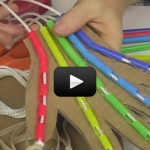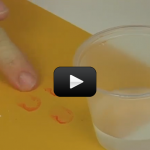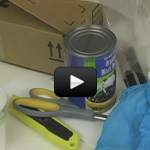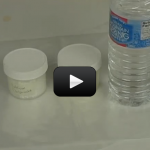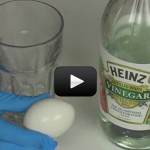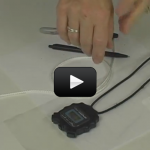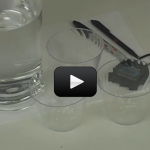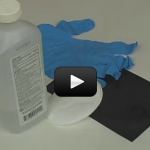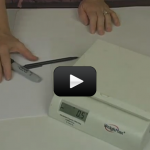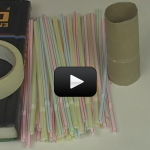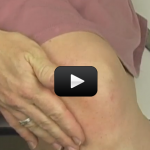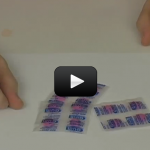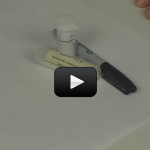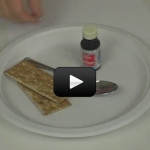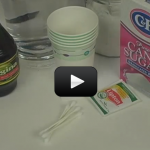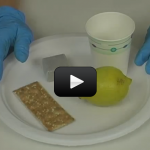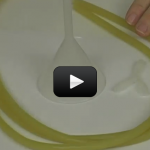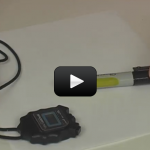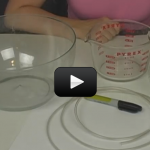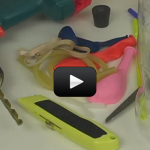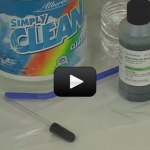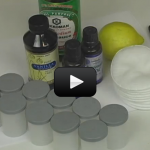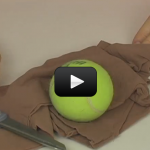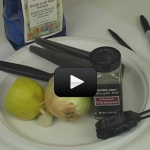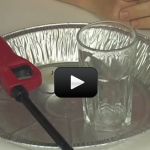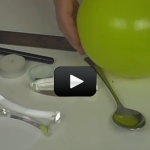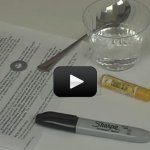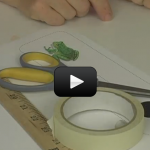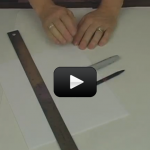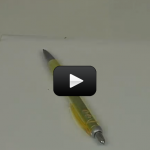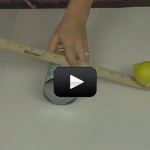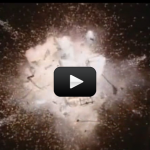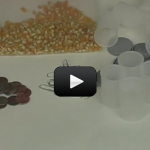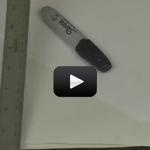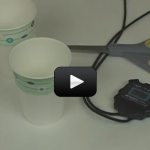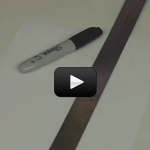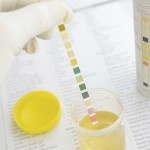Robotic Hand
Your body moves when muscles pull on the bones through ligaments and tendons. Ligaments attach the bones to other bones, and the tendons attach the bones to the muscles. If you place your relaxed arm on a table, palm-side up, you can get the fingers to move by pushing on the tendons below your wrist. … Continue reading "Robotic Hand" |
Chemical Fingerprinting
Did you know that the patterns on the tips of your fingers are unique? It’s true! Just like no two snowflakes are alike, no two people have the same set of fingerprints. In this experiment, you will be using a chemical reaction to generate your own set of blood-red prints. |
Detective Boxes
In addition to looking pretty neat with all those loops and whirls, your fingertips are great at multitasking. The skin on them has a ton of receptors that help us to gather a lot of information about our environment such as texture, movement, pressure, and temperature. This experiment will test your ability to determine textures … Continue reading "Detective Boxes" |
Detecting Temperature Changes
This experiment has two parts. For the first half, you will mix two chemicals that will produce heat and gas. The temperature receptors in your skin will be able to detect the heat. Your ears will detect the gas at it vibrates and escapes its container. In the second portion you will demonstrate a characteristic … Continue reading "Detecting Temperature Changes" |
Rubber Eggs
This lab has two parts. First, you will learn a bit about how specific chemicals react in a specific manner. And next, you will learn a bit of biology: the structure of bird bones and the minerals that compose them. |
Foggy Hands
Skin has another function that it vital to your survival: temperature regulation. Being exposed to high temperatures causes your skin’s pores to open up and release sweat onto your body. This helps cool us off by the resulting process of evaporation. Your pores will close in extremely cold temperatures. Also, the body stops blood flowing … Continue reading "Foggy Hands" |
Finger Thermometers
Your fingers have receptors which perform various jobs. In addition to touch, they can detect pressure, texture, and other physical stimuli. One specialized type of receptors is called Ruffini’s receptors. They are good at identifying changes in pressure and temperature. In this experiment, we will test their ability to distinguish between hot and cold temperatures. … Continue reading "Finger Thermometers" |
Cooling and Heating
In this experiment, we will continue to explore Ruffini’s endings in your skin. We also look at your body’s ability to detect temperature and regulate its own temperature. You will study how the body cools and warms itself. |
Testing Muscle Strength
Some groups of muscles are stronger than others because each group is designed for a different and specific function. It just makes sense that the muscle groups in our legs would need to be stronger than the ones in our toes. For this experiment, you will use a bathroom scale to test the strength of … Continue reading "Testing Muscle Strength" |
Inside Bones
The skeleton is your body’s internal supporting structure. It holds everything together. In addition to providing support, bones act as shock absorbers when you jump, fall, and run. Bones have big responsibilities and so they must be really strong. They also need to be arranged properly for the best support and shock absorption. In this … Continue reading "Inside Bones" |
Tendon Reflex
Involuntary responses are ones that you can’t control, but they are usually in place to help with survival. One good example is when you touch something hot. Your hand does not take the time to send a message to your brain and then have the brain tell your hand to pull away. By then, your … Continue reading "Tendon Reflex" |
Detecting Plaque
The buildup of things like food and bacteria where your gums and teeth meet, and also between your teeth, is called plaque. Where plaque lives is also where the bacteria turns the sugar in your mouth into harmful acids that attack your teeth’s enamel and can lead to gum disease. Regular brushing is a great … Continue reading "Detecting Plaque" |
PTC Testing
We have done some extensive experiments on taste buds: how they are categorized, what tastes they recognize, and we have even mapped their location on your tongue. But we haven’t yet mentioned this fact: not all people can taste the same flavors! So today we will check to see if you have a dominant or … Continue reading "PTC Testing" |
Testing Spit Samples
Digestion starts in your mouth as soon as you start to chew. Your saliva is full of enzymes. They are a kind of chemical key that unlock chains of protein, fat, and starch molecules. Enzymes break these chains down into smaller molecules like sugars and amino acids. In this experiment, we will examine how the … Continue reading "Testing Spit Samples" |
Mapping your Tongue
The tongue has an ingenious design. Receptors responsible for getting information are separate and compartmentalized. So, different areas on the tongue actually have receptors for different types of tastes. This helps us to separate and enjoy the distinct flavors. In this experiment, you will be locating the receptors for sweet, sour, salty, and bitter on … Continue reading "Mapping your Tongue" |
Tasty Tastebuds
Did you know that your tongue can taste about 10,000 unique flavors? Our tongues take an organized approach to flavor classification by dividing tastes into the four basic categories of sweet, sour, salty, and bitter. For this experiment, you will need a brave partner! They will be blindfolded and will be attempting to guess foods. … Continue reading "Tasty Tastebuds" |
Stethoscope
Stethoscopes are instruments used to amplify sounds like your heartbeat. Your doctor is trained to use a stethoscope not only to count the beats, but he or she can also hear things like your blood entering and exiting the heart and its valves opening and closing. Pretty cool! Today you will make and test a … Continue reading "Stethoscope" |
Heart Rate Monitoring
When you exercise your body requires more oxygen in order to burn the fuel that has been stored in your muscles. Since oxygen is moved through your body by red blood cells, exercise increases your heart rate so that the blood can be pumped through your body faster. This delivers the needed oxygen to your … Continue reading "Heart Rate Monitoring" |
What’s Your Lung Capacity?
Today you will make a calibrated, or marked, container that you will use to measure your lung capacity. You will fill the calibrated container with water, slide a hose into it, take a really deep breath, and blow in the hose. As the air in your lungs enters the container, it will push out the … Continue reading "What’s Your Lung Capacity?" |
Working Lung Model
Food and air both enter your body through your mouth, diverging when they reach the esophagus and trachea. Food goes to the gastrointestinal tract through your esophagus and air travels to your lungs via the trachea, or windpipe. You will be making a model of how your lungs work in this lab. It will include … Continue reading "Working Lung Model" |
Detecting Carbon Dioxide
An oxygen and carbon dioxide exchange takes place in your bloodstream. When you breathe air into your lungs it brings in oxygen, which is carried from your lungs by red blood cells in your bloodstream. Cells of your body use the oxygen and carbon dioxide is produced as waste, which is carried by your blood … Continue reading "Detecting Carbon Dioxide" |
Scent Matching
We now know that odor molecules are diffused throughout a room by the motion of air molecules, which are constantly moving and bumping into them. We also know that warm air moves faster than cold air, and that increasing the movement of the air (like with a fan) will increase the diffusion process. In this … Continue reading "Scent Matching" |
Swallowing
Peristalsis is the wavelike movement of muscles that move food through your gastrointestinal tract. The process of digestion begins with chewing and mixing the food with saliva. From there, the epiglottis opens up to deposit a hunk of chewed food (called bolus) into your esophagus – this is the tube that runs from your mouth … Continue reading "Swallowing" |
Diffusion
Everything living produces some sort of odor. Flowers use them to entice bees to pollinate them. We know that the tastes of foods are enhanced by the way that they smell. As humans, each of us even has own unique odor.In this lab, we look at the diffusion of scents. They start in one place, … Continue reading "Diffusion" |
Consuming Oxygen
This experiment not only explains how your body uses oxygen, but it is also an experiment in air pressure circles – bonus! You will be putting a dime in a tart pan that has a bit of water in it. Then you will put a lit candle next to the dime and put a glass … Continue reading "Consuming Oxygen" |
Eyeballoon
In this lab, we are going to make an eyeball model using a balloon. This experiment should give you a better idea of how your eyes work. The way your brain actually sees things is still a mystery, but using the balloon we can get a good working model of how light gets to your … Continue reading "Eyeballoon" |
Water Lens
Like sound, light travels in waves. These waves of light enter your eyes through the pupil, which is the small black dot right in the center of your colored iris. Your lens bends and focuses the light that enters your eye. In this experiment, we will study this process of bending light and we will … Continue reading "Water Lens" |
Disappearing Frog Experiment
Your optic nerve can be thought of as a data cord that is plugged in to each eye and connects them to your brain. The area where the nerve connects to the back of your eye creates a blind spot. There are no receptors in this area at all and if something is in that … Continue reading "Disappearing Frog Experiment" |
Visual Reflex
Voluntary nerves are the ones that are under our direct control. Others, called involuntary nerves, are under the control of our brains and create involuntary reactions. |
Camera Eyes
Your eyes have two different light receptors located on the back of the eyeball. These are the rods, which see black, white and grays, and the cones, which see color. In order to adapt to the dark, our eyes make a chemical called visual purple. This helps the rods to see and transmit what you … Continue reading "Camera Eyes" |
Human Levers
Levers are classified into three types: first class, second class, or third class. Their class is identified by the location of the load, the force moving the load, and the fulcrum. In this activity, you will learn about the types of levers and then use your body to make each type. |
Sound Speed
Sound has the ability to travel through the states of matter: solids, liquids, and gases. In this experiment we will study the movement of sound through these three states. |
Sound Matching
You know that sound comes from vibration which are picked up by the pinna (external part of the ears). Then the vibrations vibrate your tympanic membrane, which in turn vibrates the ossicles and then the cochlea. The cochlea sends information through the auditory nerve and sends it to the brain, which recognizes it as sound. … Continue reading "Sound Matching" |
Sound Whackers
Have you ever held a plastic ruler over the edge of a desk or table and whacked the end of it? If so, you would notice a funny sound. This sound changes if you change the length of the ruler that is hanging over the edge. The sound you hear is made by the ruler’s … Continue reading "Sound Whackers" |
Big Ears
How do you think animals know we’re around long before they see us? Sure, most have a powerful sense of smell, but they can also hear us first. In this activity, we are going to simulate enhanced tympanic membranes (or ear drums) by attaching styrofoam cups to your ears. This will increase the number of … Continue reading "Big Ears" |
Nerve Tester
Our sense of touch provides us with information that helps us to process and explore our world. Nerves play an important part in the sense of touch by being the wires that carry signals from the skin to the brain. But the body has a plan in place so that our brains don’t get overwhelmed … Continue reading "Nerve Tester" |
All About Kidneys
Although urine is sterile, it has hundreds of different kinds of wastes from the body. All sorts of things affect what is in your urine, including last night’s dinner, how much water you drink, what you do for exercise, and how well your kidneys work in the first place. This experiment will show you how … Continue reading "All About Kidneys" |

